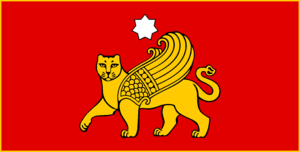Koman people
 Flag of the Komans | |
| Total population | |
|---|---|
| approx. 40–50 million (estimates vary) | |
| Regions with significant populations | |
| 42,904,651(2016) | |
| 500,000 ≥(2015) | |
| 128,300 | |
| 43,334 | |
| 7,202 | |
| Overseas | 3,000,000 ≥ (disputed) |
| Languages | |
| Koman, Balak, Qalari, Dawari | |
| Religion | |
| Primarly Shabadi Zarasaism Historically Polytheism and Vaniuan Shamanism | |
| Related ethnic groups | |
| Balaks, Mishars, Gushli people | |
Komans also known as Tamirs ( Koman, . Qamaş .; IPA: /xɒ'mäʂ/; self-designated as Tamiraş; IPA: /tɒ'miräʂ/ or Damiraş in other variants) are a Vaniuan ethnic group that originally formed in the Baykharan region during the 1th–7th centuries, primarily from Eastern Vaniuan and pre-Vaniuan tribes that moved from Northern Vaniu around 100 BCE and came to inhabit the present-day lands of Komania through several large-scale migrations after the collapse of the Kalkali nomadic state, with large contributions from former pre-Vaniuan tribes in the area.
Language
The Komans speak the Koman language, a member of the Vaniuan family from the Kalkalic (Northeastern) sub-group of Eastern Vaniuan languages, the language itself is distinguished by its total lack of affricates, fusional nature, large substratum of pre-Vaniuan loanwords and having the peculiarity of being conservative, sharing structural similarities with proto-Eastern Vaniuan. Apart from Koman, many speakers mainly inhabiting the federal state of Tarashik in Balakia are proficient in Balak as means of a lingua franca. Other languages include Qalari spoken by several tribes of the Tamyiran banner and the Dawari language spoken by a reduced cluster in the Tarkhan Mountains.
Historically, many Komans of the upper class and nobility were known for their proficiency in several languages, these included Ohanian, Kaatian and even Mishar. today most Komans inhabiting Komania are either monolingual or present a level of proficiency in several varieties.
Etymology
The term Koman arose as early as the 12th century, as Shi Oshar conquered the coastal kingdoms of Melkanchuta and established the Great Horde, he applied the term to Tamyiran tribes that previously ruled the Tamir Khanate, it is believed that the term Koman, (Koman Qaman; . Qaman .) means "of the coast" indicating their geographic location before drastically expanding eastwards. While initially not used as an ethnonym, it assured the differentiation between the tribes whom formerly inhabited the region under the name Qomandi. Komans, however, prefer to use of Tamir as endonym.
The endonym Tamir is thought to be a tribal name referring to the Tamir Khanate. A consensus of its origin is, however, still highly debatable. According to the Tamirologist and linguist Ayran Ğəren, the term Tamir might have derived from the proto-Eastern Vaniuan word for iron, reconstructed as *tɒmæɰ, following his theory, final /ɰ/ a common ending in the reconstructed corpus of PEV, suggests a possible proto-variant in which, following the phonetical developments of the Tamiric languages, might have ended with a rhotic consonant. The accuracy of his theory is still undergoing debate. A general agreement over its origin is the possibility of having pre-Vaniuan roots, a seeming possibility shown by the extensive contact between proto-Eastern Vaniuans and pre-Vaniuans, further proven by a large lexicon of pre-Vaniuan terms found in Koman.